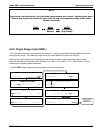
Model 360E Instruction Manual Operating Instructions
6.8.7. Dilution Ratio
The dilution ratio is a software option that allows the user to compensate for any dilution of the sample gas
before it enters the sample inlet. Using the dilution ratio option is a 4-step process:
1. Select reporting range units: Follow the procedure in Section 6.8.6.
2. Select the range: Use the procedures in Sections 6.8.2 – 6.8.5. Make sure that the SPAN value entered
is the maximum expected concentration of the undiluted calibration gas and that the span gas is either
supplied through the same dilution inlet system as the sample gas or has an appropriately lower actual
concentration. For example, with a dilution set to 100, a 10 ppm gas can be used to calibrate a 1000
ppm sample gas if the span gas is not routed through the dilution system. On the other hand, if a 1000
ppm span gas is used, it needs to pass through the same dilution steps as the sample gas.
3. Set the dilution factor as a gain (e.g., a value of 20 means 20 parts diluting gas and 1 part of sample
gas):
SAMPLE RANGE = 500.000 PPM CO2 =X.XXX
< TST TST > CAL SETUP
SETUP C.3
PRIMARY SETUP MENU
CFG DAS RNGE PASS CLK MORE EXIT
SETUP C.3 RANGE CONTROL MENU
MODE
SET UNIT DIL EXIT
DIL only appears
if the dilution ratio
option has been
installed
SETUP C.3 DIL FACTOR: 1.0 GAIN
0 0 0 1 .0 ENTR EXIT
Toggle these keys to set the dilution
factor.
This is the number by which the
analyzer will multiply the CO
2
concentrations of the gas passing
through the reaction cell.
SETUP C.3 DIL FACTOR: 20.0 GAIN
0 0 2 0 .0 ENTR EXIT
EXIT ignores the
new setting.
ENTR accepts the
new setting.
The analyzer multiplies the measured gas concentrations with this dilution factor and displays the result.
NOTE
Once the above settings have been entered, the instrument needs to be recalibrated
using one of the methods discussed in Chapter 7.
05232 Rev B3 83


















